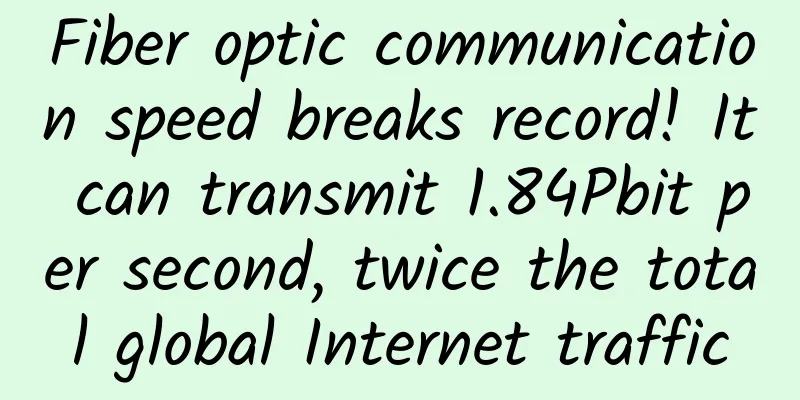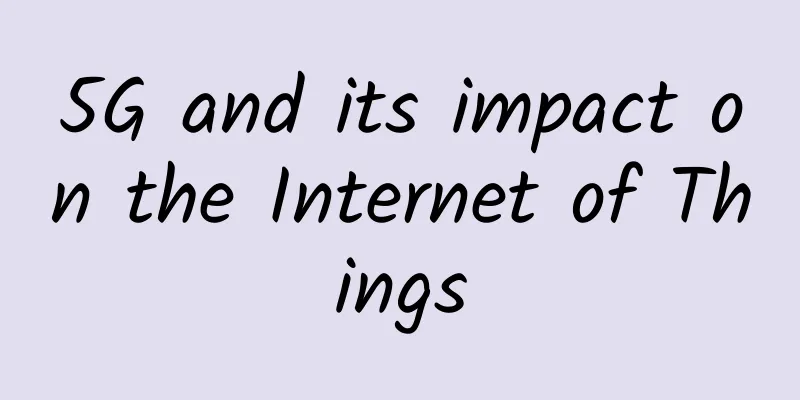Fiber optic communication speed breaks record! It can transmit 1.84Pbit per second, twice the total global Internet traffic

|
This article is reprinted with permission from AI new media Quantum Bit (public account ID: QbitAI). Please contact the source for reprinting. How fast can optical fiber information transmission be now? The latest research shows that scientists have made another major breakthrough in the speed of fiber optic communications : They successfully achieved a transmission rate of 1.84Pbit/s over an optical fiber about 8 kilometers long. What does 1.84Pbit per second mean? This is equivalent to transmitting data from about 236 1TB hard drives per second; it is also more than 20 times the speed of dedicated networks of heavyweight scientific research institutions such as NASA. Phys.org points out that this is equivalent to twice the current total global Internet traffic ! You should know that the speed of fiber optic communication was just refreshed once in May this year, rising from the Tbit level per second to the Pbit level - reaching 1.02 Pbit/s. (1Pbit=1024Tbit) Now, the record has been broken again, and the team behind it is from the University of Copenhagen in Denmark and Chalmers University of Technology in Sweden. It is worth noting that they are the first team in the world to achieve a transmission speed of more than 1Pbit per second using only "a single laser + a single optical chip" . So far, the relevant research papers have been published in Nature's top optics journal: Nature Photonics. This achievement also attracted the attention of many netizens in the Hacker Newer community. Someone excitedly said:
Customized optical chips greatly improve transmission speedThe main area involved in this research is optical fiber communication. Here let’s first talk about the basic components of the fiber-optic communication system, which includes: optical transmitters, optical receivers, optical fibers, optical cables, and repeaters. In this study, the most noteworthy part is the light source of the optical transmitter. (The optical transmitter consists of a light source, a driver, and a modulator) The researchers created a custom-designed optical chip that converts light from an infrared laser into a rainbow spectrum of many colors. Different colors of light have different frequencies. Therefore, after being processed by this chip, one frequency (color) of a single laser can even be transformed into hundreds of frequencies (colors) . And through artificial manipulation, the frequency gaps of these newly generated colors are fixed , much like the teeth on a comb. Therefore, people give this kind of spectrum a name: optical frequency comb (Frequency comb, referred to as frequency comb) . This frequency comb has two distinct advantages : First, as the source of light wave transmission, these comb structures are very suitable for wavelength division multiplexing (WDM) , where data is modulated onto each comb line and then transmitted simultaneously. Since the frequency and frequency difference between each monochromatic light are fixed, there is no need to worry about causing confusion by transmitting so much data at once. If a single laser diode array is used directly as the light source, not only will more hardware be required, but the frequency of each laser is prone to random drift, causing crosstalk between data. Second , all of this generated light is coherent, which allows digital signal processing to be performed jointly between different channels. So in summary, using a frequency comb as a light source can not only transmit multiple sets of data simultaneously without interfering with each other, but also jointly process digital signals, ultimately greatly speeding up the data transmission rate. To test the actual effect of this scheme, the researchers conducted experiments on an optical fiber. The optical fiber is 7.9 kilometers long, has 37 cores and 223 frequency channels. After analyzing and calculating the data obtained, the researchers concluded that the information transmission rate on this optical fiber reached 1.84Pbit/s. Professor Oxenløwe, co-first author of the paper, said: This solution is scalable. More frequencies can be created through technical means, and different frequencies can be sorted out in a smaller sub-space and then optically amplified, effectively solving the problems of storage space and transmission efficiency. About the Research TeamThe research was led by a team from the Niels Bohr Institute at the University of Copenhagen and the Technical University of Denmark (DTU) , with participation from scholars at Chalmers University of Technology in Sweden. The Niels Bohr Institute (one of the founders of quantum theory) was founded in 1921 and its current research areas include astrophysics, biophysics, electronic science, and quantum physics. There are three co-first authors of the paper: AA Jørgensen, D. Kong and LK Oxenløwe. LK Oxenløwe is a professor of photonic communication technology at the Technical University of Denmark and the director of the Danish Silicon Photonics for Optical Communications (SPOC) Research Center. Between 1996 and 2002, Oxenløwe obtained a Bachelor’s and Master’s degree in Physics and Astronomy from the University of Copenhagen, and a PhD from the Technical University of Denmark. His main research areas include fiber optic communications, quantum entanglement, and quantum computing. AA Jørgensen and D. Kong are both currently researchers at the Niels Bohr Institute. Paper address: https://www.nature.com/articles/s41566-022-01082-z Reference Links: [1]https://newatlas.com/telecommunications/optical-chip-fastest-data-transmission-record-entire-internet-traffic/ [2] https://phys.org/news/2022-10-transmission-laser-optical-chip.html [3]https://news.ycombinator.com/item?id=33315392 |
Recommend
As technology giants rush to enter the market, what kind of development will the satellite communications field usher in?
In recent years, the global satellite communicat...
What is the difference between 5G bearer network?
Hello everyone, I am Xiaozaojun. In today’s artic...
Long-term validity! Tencent Cloud Server Flash Sale starts at 88 yuan per year, Hong Kong 1C2G1M starts at 299 yuan per year
Tencent Cloud's 10th anniversary thanksgiving...
Is the golden mean the way to go in data centers? CommScope's new products help maximize data center network effectiveness
[Original article from 51CTO.com] After years of ...
Casbay: Malaysia/Singapore VPS monthly payment starts from $11.59, 100M unlimited traffic
The Casbay domain name has been registered since ...
Following ZTE and Huawei, China Mobile is again caught up in the "national security threat" scandal in the US
Trump reportedly blocked China Mobile from enteri...
Comparing the 5G pace of the three major operators: China Telecom advocates steady progress in four points
As the core of the next generation technology, 5G...
Let's talk about virtual mobile network security
1. Introduction With the rise of 5G technology, v...
#Has run away#Limewave: $2.7/month-2GB/20GB/5TB/Seattle data center
【Attention】This merchant has run away!!! Limewave...
Top 10 edge computing vendors to watch
Due to advances in the Internet of Things (IoT) a...
Can Chrome DevTools' Network be used like this?
If you were to pick the most used feature in Chro...
The three major operators did not learn their lesson and announced that 5G messages would be charged. Has WeChat got a new opportunity?
With over 1.1 billion users, WeChat is China’s la...
A joke is not nonsense: IP address and MAC address of high-speed rail transfer
[[433809]] This article is reprinted from the WeC...
In the era of cloud computing, what issues should data center operation and maintenance pay attention to?
In the era of cloud computing, IT system construc...
Microsoft: Open RAN is crucial to network cloudification and the two will eventually merge
In a comment document submitted to the US Federal...









